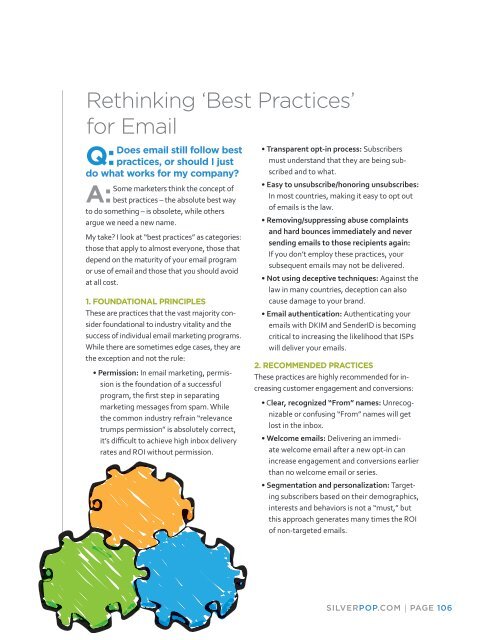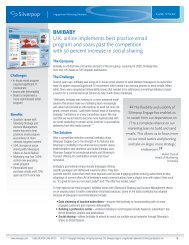eBook - Silverpop
eBook - Silverpop
eBook - Silverpop
Create successful ePaper yourself
Turn your PDF publications into a flip-book with our unique Google optimized e-Paper software.
Rethinking ‘Best Practices’<br />
for Email<br />
Does email still follow best<br />
Q: practices, or should I just<br />
do what works for my company?<br />
Some marketers think the concept of<br />
A: best practices – the absolute best way<br />
to do something – is obsolete, while others<br />
argue we need a new name.<br />
My take? I look at “best practices” as categories:<br />
those that apply to almost everyone, those that<br />
depend on the maturity of your email program<br />
or use of email and those that you should avoid<br />
at all cost.<br />
1. FOUNDATIONAL PRINCIPLES<br />
These are practices that the vast majority consider<br />
foundational to industry vitality and the<br />
success of individual email marketing programs.<br />
While there are sometimes edge cases, they are<br />
the exception and not the rule:<br />
• Permission: In email marketing, permission<br />
is the foundation of a successful<br />
program, the first step in separating<br />
marketing messages from spam. While<br />
the common industry refrain “relevance<br />
trumps permission” is absolutely correct,<br />
it’s difficult to achieve high inbox delivery<br />
rates and ROI without permission.<br />
• Transparent opt-in process: Subscribers<br />
must understand that they are being subscribed<br />
and to what.<br />
• Easy to unsubscribe/honoring unsubscribes:<br />
In most countries, making it easy to opt out<br />
of emails is the law.<br />
• Removing/suppressing abuse complaints<br />
and hard bounces immediately and never<br />
sending emails to those recipients again:<br />
If you don’t employ these practices, your<br />
subsequent emails may not be delivered.<br />
• Not using deceptive techniques: Against the<br />
law in many countries, deception can also<br />
cause damage to your brand.<br />
• Email authentication: Authenticating your<br />
emails with DKIM and SenderID is becoming<br />
critical to increasing the likelihood that ISPs<br />
will deliver your emails.<br />
2. RECOMMENDED PRACTICES<br />
These practices are highly recommended for increasing<br />
customer engagement and conversions:<br />
• Clear, recognized “From” names: Unrecognizable<br />
or confusing “From” names will get<br />
lost in the inbox.<br />
• Welcome emails: Delivering an immediate<br />
welcome email after a new opt-in can<br />
increase engagement and conversions earlier<br />
than no welcome email or series.<br />
• Segmentation and personalization: Targeting<br />
subscribers based on their demographics,<br />
interests and behaviors is not a “must,” but<br />
this approach generates many times the ROI<br />
of non-targeted emails.<br />
SILVERPOP.COM | PAGE 106







